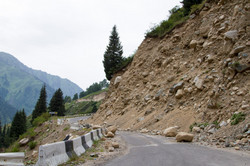Predicting landslides just got better
Landslides from excessive rainfall – especially in steep landscapes rich in soil – are among the world's most dangerous natural phenomena, often causing much loss of life and destruction. This phenomenon is expected to increase due to global warming, putting more people and communities in harm's way than ever before. The EU-funded HYLAND(opens in new window) (Hydrometeorological controls and warning procedures for shallow landslides in an Alpine region) project sought to improve understanding of rainfall conditions in order to be better prepared for landslides. To achieve its aims, the project conducted modelling studies of rainfall-triggered landslides in the Central Alps, covering sites that were impacted by such phenomena as well as others that weren't. Specifically, the project tested ways to further radar-based estimation of landslide-triggering rainfall. It also examined the relationships between initial soil wetness conditions and rainfall properties for landslide events, in addition to outlining procedures for predicting shallow landslides in Alpine regions. As a result of its research, the project team identified more accurate thresholds for critical rainfall and was able to assess the impact of rainfall sampling uncertainty on deriving these thresholds. It then underlined the strong potential of using remote sensing observations for warning applications. Achievements also included combined hydrological-geomorphological modelling to estimate critical discharge along the channel path. Overall, the project's results have added valuable new research insight to the topic, opening new avenues to explore in landslide prediction and warning. The results have been made available online to all researchers and stakeholders interested in landslide research. Improvements in understanding critical rainfall thresholds will ultimately help mitigate the risk during landslide and debris flow hazards, save lives and safeguard infrastructure.







